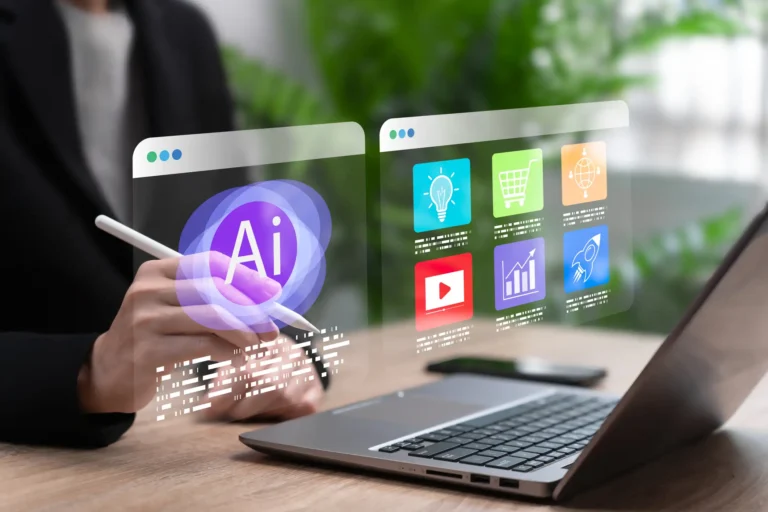Ever since Open AI broke the internet when it launched ChatGPT in November 2022, AI has been a constant hot topic — especially in B2B marketing circles. As a content creator, I’ve been exploring all of the possibilities, and pitfalls, that AI has to offer. (So has Dave Foster, who chronicled his AI journey in this recent blog post). Through my AI education, I’ve attended webinars, downloaded white papers and bookmarked more online articles than I’d like to admit. Along the way, I’ve learned a thing or two about AI — and now it’s time for show and tell.
Let’s start at the top.
AI versus ML versus DL
AI is a broad field that includes two main subsets: machine learning (ML) and deep learning (DL). Machine learning enables machines to learn from data without being explicitly programmed, while deep learning uses artificial neural networks to learn and make sense of complex data. While machine learning typically requires human engineers, deep learning can interpret raw data without humans. This chart from Advanced Analytics further defines the differences between machine and deep learning.
A closer look at AI terms to add to your marketing strategy playbook.
Ad Personalization involves tailoring marketing content and experiences to individual users based on their preferences, behavior and demographics. AI-powered personalization algorithms can significantly enhance engagement and conversion rates and are built into many of the ad platforms you’re probably already using, including all of the biggies: Meta, Google (and other search engines), YouTube and LinkedIn, to name a few.
Algorithms are the sets of rules or instructions followed by AI systems to solve problems or perform tasks. Understanding different algorithms is essential for selecting the right approach to specific marketing challenges. Algorithms are the fuel that makes every AI-powered engine run.
Automated Bid Management uses AI algorithms to adjust bid strategies in real time based on campaign performance and business objectives. Our digital marketing team uses this AI-powered technology to optimize bidding across platforms, thereby maximizing the efficiency of our clients’ ad spend. (Side note: If you want to learn more about the essential digital channels for B2B marketers, check out our recent blog post, “Navigating the digital landscape”.)
Chatbot is a computer program designed to simulate conversation with human users, typically through text or voice interfaces. B2B marketers can use chatbots to provide customer support, engage website visitors and even help qualify leads. Chatbots have been around for a while, but AI has made them even smarter thanks to NPL. (What’s NPL? Just wait — that definition is coming right up.)
Data Mining is the process of discovering patterns and insights from large datasets. It involves techniques such as clustering, classification and association rule mining to extract valuable information. Unless you’re a data scientist, chances are you’re not going to book a data-mining adventure. The key takeaway here is to understand the concept and know that major marketing tools (Salesforce, HubSpot, Google Analytics, etc.) incorporate data mining into their offerings. If you really want to geek out on the topic, check out this Salesforce article.
Dynamic Creative Optimization (DCO) leverages AI to deliver personalized ad designs tailored to individual users in real time. Marketers can use DCO to dynamically adjust ad content based on audience preferences, driving engagement and conversions. Some of the biggest players in this market include Google’s Display and Video 360 and Adobe’s Advertising Cloud, which incorporate DCO into their platforms.
Generative AI. In most cases when we use the term AI in creative circles, we’re really talking about generative AI — which refers to the use of algorithms to create new content, including audio, code, images, text, simulations and videos. At AvreaFoster, Gen AI has changed how we view creative projects, allowing us to more efficiently develop content. The rules around who owns the content created through Gen AI is murky. At AvreaFoster, we limit our use of generative AI to modifying files (photos, illustrations or videos) we own and avoid the use of any image or video created solely through AI.
Intent Data Analysis involves analyzing signals of purchase intent, such as online search behavior or content consumption patterns. B2B marketers can leverage AI to interpret intent signals, identify prospects in active buying cycles and deliver targeted messaging at the right moment. Platforms, including Salesforce and ZoomInfo, use intent data to help sales and marketing teams identify their hottest pursuits, which can help streamline efforts and stretch digital marketing budgets.
Lookalike Modeling uses AI algorithms to identify people who closely resemble a company’s existing customers. This suggests they’re likely to be interested in the company’s product or service, improving targeting and ad relevancy. We’ve been using lookalike modeling in our media strategies for years. As AI has evolved, this approach — and the results it delivers — have dramatically improved. For a deeper dive into the benefits of AI-powered lookalike modeling, check out this article from Appier.
Natural Language Processing (NLP) is a branch of AI that enables computers to understand, interpret and generate human language. It is the power behind applications such as chatbots, sentiment analysis and language translation. As NLP has matured, its application across tools has dramatically improved, making today’s chatbot encounters a lot less robotic than they were just a few years ago.
Predictive Analytics involves using historical data, statistical algorithms and ML techniques to forecast future outcomes. B2B marketers can leverage predictive analytics to anticipate customer behavior and optimize marketing campaigns. Predictive analytics is a fascinating topic, especially among B2B sales and marketing teams, with its own rabbit holes to explore. A good place to start is this insightful article from CMSWire.
Predictive Lead Scoring uses AI algorithms to analyze data and predict the likelihood that a lead will convert into a customer. By prioritizing leads with the highest propensity to convert, B2B marketers can optimize resource allocation and improve client ROI.
Programmatic Advertising automates the buying and placement of digital ads using AI-powered algorithms. While programmatic advertising networks have been around since the early 2000s, AI has increased their sophistication, allowing marketers to further optimize targeting, reach niche audiences and deliver campaigns at scale.
Prompt Engineering involves crafting effective prompts to guide AI models when generating output, including pieces of written content, photos and videos. In today’s AI-centric environment, it’s increasingly important that your marketing teams understand how to use AI to its fullest potential — and it all starts with being an experienced prompt engineer. To learn more about the topic, check out this Fast Company article.
Recommendation Engine is a system that analyzes user data to provide personalized recommendations for products, content or services. Once considered a tool limited to consumer brands (think Amazon and its advanced recommendation feature), AI has made this technology a viable solution for B2B marketers who need to cross-sell relevant products or nurture leads with content.
Sentiment Analysis, also known as opinion mining, involves analyzing text data to determine the sentiment or emotion expressed by the author. It can help B2B marketers gauge customer satisfaction, identify trends and manage brand reputation. For a deeper dive, explore this article from Sprout Social.
That’s a wrap, for now.
AI is a field that is in a constant state of evolution. Every day brings new trends to uncover, tools to investigate and AI-powered opportunities to explore. At AvreaFoster, our exploration of AI is ongoing. As innovations emerge, we’ll update this glossary and share new terminology and additional resources. Be sure to bookmark this page and join us as we continue to navigate the world of AI.
Ready to put some of these AI tools to work in your business-to-business marketing efforts? Let’s connect.



